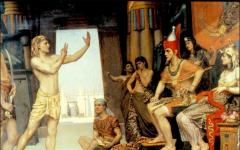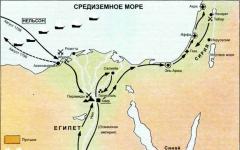Morning toilet. Robe of Osiris.
The awakening of the ruler always began with a hymn in honor of the rising sun and was accompanied by an elaborate ceremony that prepared him for the morning exit. The pharaoh rose from his bed and washed himself with rose water in a gilded bath. Then his divine body was rubbed with aromatic oils under the whisper of prayers, which had the property of driving away evil spirits. At the royal court, a special event was the morning toilet ceremony of the pharaoh. In the presence of the entire family, especially close courtiers and scribes who held long papyri in their hands for writing, specially trained servants fussed over him. The barber shaved his head and cheeks, and he used razors with different blades. The razors were placed in special leather cases with handles, and these, in turn, were placed in elegant ebony caskets, which also contained tweezers, scrapers, and nightlights for manicure and pedicure. Having completed the first part of the toilet, the godlike man with a smoothly shaved head and a short beard, fresh and vigorous, passed into the hands of the next specialists who were engaged in his make-up. They kept their paints in small vessels made of glass and obsidan. In elegant spoons they diluted dry paints from carefully ground malachite, galena (lead eye gloss), antimony and clay pigments.
This is how Tutankhamun described his morning dressing during his stay on the island of Crete, as an ambassador, D.S. Merezhkovsky (“The Birth of the Gods. Tutankhamun on Crete”): ... In front of a mirror made of red copper, a special master lined his eyes. The master tried on his shaved head with wigs of various designs - vaulted, bladed, tiled. The barber offered him two types of beards tied with ribbons: Amon's cube made of hard horsehair and Osiris' flagellum made from the blond hair of Libyan wives. The guard brought a white dress made of the finest “royal linen” - “woven air”, all in flowing folds; the wide sleeves in feathery folds looked like wings, the tightly starched apron protruded forward in a multi-fold transparent, as if a glass pyramid. When Tuta got dressed... he looked like a cloud: he was about to flutter up and fly away.”

Joseph Interpreting Pharaoh's Dream, 1894
The royal outfit was not just luxurious, it had to correspond to the divine essence of its owner. Therefore, the morning ceremony was completed by decorating the royal person with precious symbols of royal power. The necklace or mantle was made of strung gold plates and beads with a flat clasp at the back, from which a golden tassel of chains and flowers of amazingly fine and exquisite workmanship descended down the back. Such necklaces appeared shortly before the era of Ramses. The classic mantle was made up of numerous rows of beads. The last one, lying on the chest and shoulders, had a teardrop shape, all the others were round or oval. It was also decorated with two falcon heads. The mantle was held on by two laces, which were tied at the back. In addition to the necklace, the pharaoh wore a chest decoration with an image of a temple on a double gold chain. Three pairs of massive bracelets adorned the hands and feet: wrists, forearm and ankles. Sometimes a long, thin tunic was worn over the entire costume, tied with a belt made of the same fabric.
Cleansed and fumigated with incense, fully clothed, the pharaoh walked to the chapel, tore off the clay seal from its doors and alone entered the sanctuary, where a wonderful statue of the god Osiris reclined on an ivory bed. This statue had an extraordinary gift: every night its arms, legs and head, cut off by the once evil god Set, fell off, and the next morning, after the prayer of the pharaoh, they grew again by themselves. When the most holy ruler was convinced that Osiris was safe again, he took him from his bed, bathed him, dressed him in precious clothes and, seating him on a malachite throne, burned incense before him. This ritual was extremely important, since if the divine body of Osiris did not grow together one morning, this would be a harbinger of great disasters not only for Egypt, but for the whole world. After the resurrection and vestment of the god Osiris, the pharaoh left the door of the chapel open so that the grace emanating from it would pour out throughout the whole country; he himself appointed priests who were supposed to guard the sanctuary, not so much from the evil will of people, but from their frivolity, as it happened more than once that someone, carelessly coming too close to his place, received an invisible blow that deprived him of consciousness, and sometimes even life. (B. Prus “Pharaoh” description of the life of Ramses XII)
Pharaoh's breakfast
Having completed the ritual of worship, the pharaoh, accompanied by priests singing prayers, went to the large refectory hall. There was a table and a chair for him and nineteen other tables in front of nineteen statues representing the nineteen previous dynasties. When the pharaoh sat down at the table, young girls and boys ran into the hall, holding silver plates with meat and sweets and jugs of wine in their hands. The priest, who oversaw the royal kitchen, tasted food from the first plate and wine from the first jug, which the servants, kneeling, then served to the pharaoh, and other plates and jugs were placed in front of the statues of the ancestors. After the pharaoh, having satisfied his hunger, left the refectory hall, the dishes intended for the ancestors were passed on to the royal children and priests.
Pharaoh's work
The life of the pharaoh, both public and personal, was strictly regulated. Morning time was reserved for government affairs. From the refectory, the pharaoh headed to an equally large reception hall. Here the most important state dignitaries and closest members of the family greeted him, falling on their faces, after which the Minister of War, the High Treasurer, the Chief Justice and the Supreme Chief of Police reported to him on the affairs of the state. The reports were interrupted by religious music and dancing, during which the dancers covered the throne with wreaths and bouquets.

James Tissot. Joseph and His Brethren Welcomed by Pharaoh (1900)
Prophetic dreams of the pharaoh
After this, the pharaoh went to a nearby office and rested for several minutes, lying on the sofa. Then he poured libations of wine before the gods, burned incense, and told the priests his dreams. Interpreting them, the sages drew up the highest decrees on matters awaiting the decision of the pharaoh. But sometimes, when there were no dreams or when their interpretation seemed wrong to the ruler, he smiled complacently and ordered to do such and such. This order was a law that no one dared to change, except in detail.
Supreme grace
In the afternoon hours, the God-equal, carried in a stretcher, appeared in the courtyard in front of his faithful guard, after which he climbed onto the terrace and, addressing the four cardinal directions, sent them his blessing. At this time, flags fluttered on the pylons and powerful sounds of trumpets were heard. Anyone who heard them in the city or in the field, be it an Egyptian or a barbarian, fell on his face so that a particle of the highest grace would descend on him. At such a moment it was impossible to hit either a person or an animal, and if a criminal sentenced to death could prove that the sentence was read to him during the pharaoh’s exit to the terrace, his punishment was commuted. For ahead of the ruler of earth and sky walks might, and behind is mercy.

James J. Tissot, "Pharaoh Notes the Importance of the Jewish Peopler" (1896-1900)
Blessed Touch
Having made the people happy, the ruler of all things under the sun descended into his gardens, into the thicket of palm trees and sycamore trees, and rested there, receiving tribute from his women and admiring the games of the children of his house. If one of them attracted attention with his beauty or dexterity, he called him over and asked:
Who are you, baby?
“I am Prince Binotris, the son of Pharaoh,” answered the boy.
What's your mother's name?
My mother is Lady Ameses, Pharaoh's woman.
What can you do?
I can already count tens of ten and write: “May our father and God, holy Pharaoh Ramses, live forever!”
The Lord of Eternity smiled benevolently and with his gentle, almost transparent hand touched the curly head of the lively boy. From that moment on, the child was truly considered a prince, although the pharaoh continued to smile mysteriously. But whoever was once touched by the divine hand should not have known grief in life and was elevated above the rest.
The end of the day of the godlike pharaoh
For dinner, the ruler went to another refectory, where he shared dishes with the gods of all the nomes of Egypt, whose statues stood along the walls. What the gods did not eat went to the priests and high courtiers.
In the evening, the pharaoh received Mrs. Nicotris, the mother of the heir to the throne, and watched religious dances and various performances. Then he went back to the bathroom and, having cleansed himself, entered the chapel of Osiris to undress and lay down the wonderful god. Having done this, he locked and sealed the doors of the chapel and, accompanied by a procession of priests, headed to his bedchamber.”

The intimacy of the relationship between a young couple - a young pharaoh and his wife - is conveyed in the gesture of the fragile queen, with which she brings a small bouquet of flowers to her husband, as if inviting him to inhale the aroma of spring primroses. The color scheme of the picture also creates a feeling of joy: a combination of fawn, bluish and light green tones. The pharaoh's costume consists of a white shenti, over which a sindon of white transparent fabric is draped. The ends of the sindon, thrown over the front, are richly embroidered and finished with relief metal stripes. On the inside, the sindon is reinforced with a belt, the long ends of which descend from the right and left sides. They are embroidered with transverse stripes. The small wig is decorated with a uraeus, and at the back there are two ribbons of the same fabric as the belt. In the right hand there is a staff - a symbol of the power of the pharaoh. The shoulders and chest are covered with a uskh made of colored plates. The costume of the pharaoh's wife is much less decorated. It consists of two main parts - a long kalasiris made of light transparent fabric and a “haik of Isis” coverlet made of the same white, but even more transparent fabric.
The generally accepted designation of ancient Egyptian kings, since the XXII dynasty the title of king. The term Pharaoh comes from the ancient Egyptian word pero (literally, great house), rendered by biblical tradition as Pharaoh. Originally the term Pharaoh meant... Encyclopedia of Mythology
- (French faraon, Hebrew paroh king). 1) The name of the ancient Egyptian kings. 2) a gambling game of French cards, so named because one of the kings portrayed the pharaoh. Dictionary of foreign words included in the Russian language. Chudinov A.N.,... ... Dictionary of foreign words of the Russian language
Designation of ancient Egyptian kings, later the title of king. The term pharaoh comes from the ancient Egyptian great house. Initially it designated the royal palace, and later from the 16th century. BC the king himself. The pharaoh wore different crowns: white like the king... ... Historical Dictionary
Nickname of the policeman (Ushakov) See... Dictionary of synonyms
- (Egyptian translation about, big house), Egyptian title. king, in the Bible is often used as a proper name. In this regard, numerous arise. difficulties in identifying the personalities named in the Bible by F., since the bib. reports about them are undoubtedly not... Brockhaus Biblical Encyclopedia
PHARAOH, pharaoh, husband. (Greek pharao from Egyptian). 1. Title of ancient Egyptian kings (historical). 2. Nickname of a policeman (pre-modern simple contempt). 3. only units. A type of card gambling similar to baccarat. "The ladies played pharaoh." Pushkin. Dictionary... Ushakov's Explanatory Dictionary
Pharaoh- PHARAOH, ah, m. Policeman. Wed. outdated ug. "Pharaoh" policeman, gendarme... Dictionary of Russian argot
Ancient Egyptian king. He was considered the son of the Sun God and had unlimited power... Legal dictionary
Traditional designation for ancient Egyptian kings, from the 16th century. BC e. king's title. Comes from the Egyptian pero (big house) in the original meaning of the royal palace... Big Encyclopedic Dictionary
PHARAOH 1, a, m. Ozhegov’s Explanatory Dictionary. S.I. Ozhegov, N.Yu. Shvedova. 1949 1992 … Ozhegov's Explanatory Dictionary
PHARAOH 2, a, m. A type of gambling card game. Ozhegov's explanatory dictionary. S.I. Ozhegov, N.Yu. Shvedova. 1949 1992 … Ozhegov's Explanatory Dictionary
Books
- Pharaoh, Boleslaw Prus. PHARAOH Prusa differs from his literary predecessors primarily in the absence of a self-sufficient love affair. The theme of Prus's novel is the political struggle for power, depicted...
- Pharaoh, Boleslaw Prus. "Pharaoh" is a historical novel by the famous Polish writer Boleslaw Prus from the life of Ancient Egypt. The work touches on many important issues: the plight of the people, the role of the people...
Pharaoh played a special role in the life of the Egyptians. This word cannot be translated as king, king or emperor. The pharaoh was the supreme ruler and at the same time the high priest. Pharaoh was a god on earth and a god after death. He was treated like a god. His name was not taken in vain. The term “pharaoh” itself came from the combination of two Egyptian words per - aa, which meant great house. This is how they spoke about Pharaoh allegorically, so as not to call him by name.
According to the beliefs of the Egyptians, the first pharaoh was the god Ra himself. Other gods ruled behind him. Later, the son of Osiris and Isis, the god Horus, appears on the throne. The choir was considered the prototype of all Egyptian pharaohs, and the pharaohs themselves were his earthly incarnation. Every real pharaoh was considered a descendant of both Ra and Horus.
The full name of the pharaoh consisted of five parts, the so-called titulature. The first part of the title was the name of the pharaoh as the incarnation of the god Horus. The second part was the name of the pharaoh as the incarnation of two mistresses - the goddess of Upper Egypt Nekhbet (depicted in the form of a kite) and the goddess of Lower Egypt Wadjet (in the form of a cobra). Sometimes the “sustained phenomenon of Ra” was added here. The third part of the name was the name of the pharaoh as the “golden Horus.” The fourth part included the personal name of the king of Upper and Lower Egypt. For example, the personal name of Pharaoh Thutmose 3 was Men - Kheper - Ra. And finally, the fifth part of the title was what can be roughly translated as a patronymic. It was preceded by the words “son of Ra”, and then followed by the second name of the pharaoh, for example Thutmose - Nefer - Kheper. It was this that usually served as the official name of the pharaoh.
It was also believed that pharaohs appear from the marriage of the queen, the wife of the pharaoh, with some deity. Kinship in the pharaoh dynasty was conducted through the maternal line.
It wasn't just men who ruled - the pharaohs. Queen Hatshepsut is famous in history. In all Egyptian temples, the living pharaoh was sung as a god and prayed for his health and well-being. Pharaoh himself also addressed prayers to the gods. In the minds of the Egyptians themselves, the pharaoh was represented as a god-man. It was believed that there was an unbreakable agreement between the gods and the pharaohs, according to which the gods granted the pharaoh longevity, personal well-being and prosperity of the state, and the pharaoh, for his part, ensured the gods' observance of the cult, the construction of temples and the like. He was the only mortal who had access to the gods.
Sometimes the pharaoh personally participated in the beginning of agricultural work, which was of a sacred nature. He threw a scroll into the Nile with the order to begin the flood, he begins preparing the soil for sowing, he is the first to cut the first sheaf at the harvest festival and offers a thanksgiving sacrifice to the goddess of the harvest, Renenut. In Egypt there was a constant struggle for the throne of Upper and Lower Egypt. Priests played an important role in it. Sometimes they founded a new dynasty of pharaohs. Often the pharaohs were puppets in the hands of the high priest. The fight went on almost without a break. With the weakening of the state, separatist sentiments immediately reared their heads in various regions of Egypt.
Pharaoh is the son of god. His main duty is to bring gifts to the gods and build temples for them. Ramesses III addressed the gods this way: “I am your son, created by your hands... You have created perfection for me on earth. I will fulfill my duty in peace. My heart tirelessly seeks what needs to be done for your sanctuaries.” Next, Ramesses III tells which temples he built and which he restored. Each pharaoh built himself a tomb - a pyramid. The pharaoh also appointed governors of nomes (nomarchs), chief officials, and the chief priest of Amun. During the war, the pharaoh led the army. According to tradition, the pharaohs brought trees and shrubs unknown to the Egyptians from long campaigns. The pharaohs paid great attention to the construction of irrigation systems and personally supervised the construction of canals.
Awards for the best
The pharaohs valued and in every possible way encouraged their military leaders and officials, who served as the main support of their power and might and brought them wealth. After the campaign, rewards were given to those who distinguished themselves. Sometimes one person received the reward. A big celebration was held in honor of the victory. Luxurious gifts were laid out on tables. Only the highest nobility were allowed to attend the celebration.
Coronation
The ritual of the coronation of the pharaohs was subject to established rules. But at the same time, there were some differences depending on the day of the ritual. It depended on which god the coronation day was dedicated to.
For example, the coronation of Ramesses III took place on the holiday of the god Min, the lord of the desert and fertility. The pharaoh himself led the solemn procession. He appeared in a chair, which was carried on a stretcher by the king's sons and high officials, which was considered a great honor. The eldest son, the heir, walked in front of the stretcher. The priests carried a censer with incense. A scroll in the hands of one of the priests represented the program of the holiday. Approaching Min's dwelling, the pharaoh performed the ritual of incense and libation. Then the queen appeared. Next to her walked a white bull with a solar disk between its horns - a symbolic personification of God. It was also fumigated with incense. The procession sang hymns. The priests carried wooden statues of various pharaohs. Only one of them, the apostate Akhenaten, was forbidden to “appear” at the festival. The pharaoh aimed four arrows in each direction of the world: thereby he symbolically defeated all his enemies. With the singing of hymns, the ceremony comes to its final stage: the ruler thanks Min and brings him gifts. The procession then retired to the pharaoh's palace.
Personal life of the pharaoh
The pharaohs had different attitudes towards their wives and families. For example, Akhenaten almost never left his palace. He loved his wife, mother and daughters dearly. Reliefs have reached us that depict his family during their walks. They went to church together, the whole family even took part in receiving foreign ambassadors. If Akhenaten had one wife, then Ramses II had five, and they all bore the title of “great royal wife.” Considering that this pharaoh reigned for 67 years, this is not that long. However, in addition to official wives, he also had many concubines. From both of them he left 162 offspring.
Dwelling of Eternity
No matter how important the concerns of life were, Pharaoh had to think in advance what his eternal dwelling would be like. Building even a small pyramid was not an easy task. Granite or alabaster blocks suitable for this were found only in two places - on the Giza and Saqqara plateaus. Later, entire halls connected by passages began to be cut down in the Theban mountains for the rest of the pharaohs. The sarcophagus was considered the main thing in the funeral ceremony. The pharaoh personally visited the workshop where the sarcophagus was being made for him, and meticulously observed the work. He cared not only about the burial place, but also about the objects that would accompany him in the afterlife. The wealth and variety of utensils is amazing. After all, in the world of Osiris, the pharaoh had to continue his usual life.
Pharaoh's funeral
The funeral of the pharaoh was a special spectacle. Relatives sobbed and wringed their hands sadly. Undoubtedly, they sincerely mourned for the departed. But it was believed that this was not enough. Professional mourners and mourners, who were excellent actors, were specially invited. Having smeared their faces with mud and stripped themselves to the waist, they tore their clothes, sobbed, moaned and beat themselves on the head.
The funeral procession symbolized the relocation from one house to another. In the other world, the pharaoh should not have needed anything. At the front of the procession were carried pies, flowers and jugs of wine. Next came funeral furniture, chairs, beds, as well as personal belongings, utensils, boxes, canes and much more. The procession concluded with a long line of jewels. And here is the mummy of the pharaoh in the tomb. The wife falls to her knees and wraps her arms around him. And at this time, the priests perform an important mission: they place “trismas” on the tables - bread and mugs of beer. Then they put in an adze, a cleaver in the shape of an ostrich feather, a dummy of a bull's leg, a palette with two curls on the edges: these items are needed to eliminate the effects of embalming and give the deceased the opportunity to move. After performing all the rituals, the mummy is immersed in a stone “grave” to move on to a better world and lead a new life.
According to mythology, in ancient times Egypt was ruled by gods. But then the gods left Egypt, leaving in their place the pharaohs - their sons.
Title and attributes
In grade 5, you learned that Egypt was originally divided into two kingdoms - Upper and Lower. Each of them was ruled by its own autocrat, however, later, during the wars, Egypt was united under the rule of one ruler.
The naming of the pharaoh consisted of five names. The first was associated with the god Horus. It spoke of the people's faith in his holiness. The second was associated with the goddesses Nekhbet and Wadjet, patronesses of Upper and Lower Egypt. The third name is golden, symbolizing eternity. The fourth name was the throne name, and the fifth was personal and received during life.
The pharaohs were forbidden to be in public without a headdress called a pschent, which was an amalgamation of the separate crowns of Upper and Lower Egypt. Also, unlike the white scarves of commoners, the pharaohs of Ancient Egypt wore gold scarves with blue stripes.
The symbols of the pharaoh's power were a short staff with a hook at the top, a whip, the Uas scepter, which had a forked lower end and a jackal's head at the top, as well as a cross with a loop, called the ankh - a symbol of eternal life.
An important feature of the rulers was a false beard, which was also worn by female pharaohs.
TOP 2 articleswho are reading along with this
After death, the pharaohs, who had unconditional divine origin, were subjected to embalming and then mummification. Their body was placed in stone sarcophagi and immersed first in mastabas, and from the time of Pharaoh Djoser - in pyramids, which were their tombs. There the pharaohs were supposed to reunite with the gods.
List and description of the pharaohs of Ancient Egypt
The first pharaoh of the First Dynasty was Narmer Menes (3060-3007 BC).
It was he who united Egypt and began to rule both parts of it.

Rice. 1. Map of Upper and Lower Egypt.
Egypt experienced a golden age under Pharaoh Djoser, the second representative of the 3rd dynasty. It was under him that the construction of the pyramids began. Djoser carried out many military campaigns and was able to subjugate the Sinai Peninsula.
Under Pharaoh Cheops (Khufu), the tallest pyramid was built, which is the only surviving wonder of the world.

Rice. 2. Pyramid of Cheops.
The reign of Queen Hatshepsut was also wonderful for Egypt. She organized an expedition to Punt, developed architecture and conducted military campaigns.
The list of pharaohs who waged wars of conquest and expanded their borders also includes Amenhotep 4, Seti 1, Amenhotep 3, Thutmose 3.
Under Thutmose 3, Egypt reached its maximum expansion to the northwest, possessing Syria and the eastern coast of the Mediterranean. Only the troops of Assyria and Babylon were able to stop Thutmose 3 in his campaigns.
The main directions of the pharaohs' aggressive activities were not only the Middle East. In the south, on the Tigre plateau from the 5th to the 4th century BC. there was the kingdom of D'mt, and not far to the west of it was Egypt's most evil enemy - Nubia. Nubian slaves were highly valued in Egypt.
Religious reforms were actively carried out under Akhenaten. He abolished the worship of the gods, replacing them with the cult of the pharaoh. The reforms did not find support among the people and after the death of the ruler they were canceled.
The last great pharaoh was Ramses 2. He was able to unite all historical territories under his rule. After the death of Ramses, Egypt weakened significantly, plunging into internecine wars for power.

Rice. 3. Image of Ramses 2.
1000 years after Ramses 2, Egypt will lose its sovereignty, first seized by Alexander the Great and becoming Hellenistic, and after the death of Cleopatra it will become a province of the Roman Empire.
What have we learned?
In Ancient Egypt, the pharaohs were considered the sons of the gods, and therefore aroused respect and veneration. They had unlimited power and went down in history as the rulers of one of the most ancient states of Civilization.
Test on the topic
Evaluation of the report
Average rating: 4.6. Total ratings received: 395.
The Egyptian kings were treated as real living gods. They were the rulers of one of the first great civilizations, they lived in luxury, and in their hands was power hitherto incredible for one person.
Egyptian rulers lived happily while hundreds or even thousands of people died during the construction of magnificent pyramids and statues in their honor. And when the pharaohs themselves died, they were buried in giant tombs that hid their bodies from prying eyes for almost 4,000 years.
In the history of mankind, no one before had such absolute power and influence and lived in such prosperity as the pharaohs. Sometimes such omnipotence greatly spoiled the kings, which is not surprising for imperfect human nature.
10. Pygmy obsession and Pharaoh Pepi II

Pepi The Second was about 6 years old when he became king of Egypt, meaning he was just a small child when he was entrusted with ruling over an entire kingdom. Undoubtedly, much more power was concentrated in the hands of Pepi than should be trusted to a 6-year-old fool.
It is not surprising that the young king was a very spoiled child from childhood. Shortly after his accession to the throne, Pepi received a letter from an explorer named Harkhuf, in which he told the pharaoh a story about an encounter with a dancing pygmy (a representative of a short African people living in the equatorial forests). This message so amazed and inspired the pharaoh that he wanted to see the strange pygmy in person.
“Drop everything and come with him to my palace!” Pepi wrote in response. The child ordered that nothing happen to Harkhuf and took serious care of the security. “When you board the boat, gather your trusted servants and let them surround the pygmy on all sides as he walks along the ladder so that he does not fall into the water under any circumstances! When the pygmy goes to sleep in his hammock, people devoted to you should also lie around him. Check it 10 times every night!” the Pharaoh strictly ordered. As a result, Pepi received his pygmy safe and sound.
Since childhood, he has been accustomed to getting everything he wants and considering himself much more important than anyone else on Earth. By the time he reached adulthood, the pharaoh was already such a spoiled and capricious person that he even forced his slaves to smear themselves with honey and walk around him naked so that Pepi would not be bothered by flies.
9. Giant genital monuments of King Sesostris

Sesostris was one of the greatest military leaders in Egyptian history. He sent warships and armies to all corners of the known world and extended the Egyptian kingdom further than any other ruler of that empire. After each battle, in honor of his success, Sesostris erected huge columns depicting genitals.
The king left these pillars at the sites of all his battles. Many of them were engraved with texts about who he was, how he defeated his enemy, and about his confidence in divine approval of his policy of invading all foreign countries.
In addition, Sesostris left a detail on these columns that was intended to characterize the army of the defeated enemy. If the opponents were strong and fought with dignity, he added an image of a penis to the monument. But if the enemy was weak, an engraving in the form of a female genital organ appeared on the monument.
These columns were erected throughout the mainland, and lasted for a long time. Even the famous ancient Greek historian Herodotus saw several pillories of Sesostris. 1,500 years later, some of them still stood in Syria, a reminder of the defeats of their ancestors.
8. Urine washing and Pharaoh Feros

Sesostris's son, Pheros, was blind. Perhaps it was a hereditary disease, but the official version of the Egyptian chronicles said that the heir to the throne was cursed. According to legend, the Nile began to flood the banks of the empire, and Feros became angry that the river was causing damage to his kingdom. Enraged, he threw his spear at her. The pharaoh hoped that in this way he would pierce the bottom of the Nile and release all the water, but the gods, outraged by his audacity, cursed the ruler with blindness.
After 10 years, the oracle told Feros that his vision could be restored. All that is required is to wash your face with the urine of a woman who has never slept with anyone other than her own husband.
Feros tried washing his eyes with his wife's urine, but it didn't help. He never regained his sight, and his wife just threw up her hands, assuring that she had not cheated on him. Then Pharaoh gathered all the women in the city, ordered them all to go to the toilet in the same jug in turn, and one by one poured its contents over his eyes.
It worked. After several dozen women, Feros found the most faithful Egyptian woman and was healed. To celebrate, the king married this girl and burned his former wife. At least that's what the legend says. Although it is unlikely that the pharaoh’s sight was saved by magic urine, and perhaps such a story was invented to justify his strange addiction to female urine.
7. Hatshepsut's fake beard

Hatshepsut was one of the few women awarded the reign over ancient Egypt. She had big plans for the empire, but on the path to success the queen had to overcome some obstacles. At that time, Egypt, although it was a much more progressive country than others, women were not treated equally here, and therefore the queen had a hard time.
To make her situation easier, she even ordered her people to always paint her as a man. In all images, Hatshepsut was supposed to be presented to the public with a muscular body and a beard. The queen called herself the “Son of Ra” and supposedly also always wore a fake beard in public. It seemed to her that this way ordinary subordinates and noble Egyptians would take her more seriously.
Hatshepsut managed to do a lot of good things for her kingdom, and she thought that her tricks and dressing up as a man were largely the reason for this. However, her son ended up doing everything he could to erase his mother's legacy from the country's history so that no one would know that Egypt was ruled by a woman. He succeeded so well that until 1903 no one suspected that Hatshepsut was a woman.
6. The Bad Smelling Diplomacy of King Amasis

Amasis was not the most polite and well-mannered king in the history of ancient Egypt. He was not only an alcoholic, but also a kleptomaniac - the pharaoh stole the things of his friends, and then convinced them that these things were never theirs.
He acquired the throne by force. The former king of the empire sent him to suppress the uprising, but when Amasis arrived, he realized that the rebels had a very good chance of victory. It was then that he decided to lead them, instead of fulfilling the instructions of the legitimate pharaoh. Amasis was not a sophisticated diplomat, so he declared war very rudely - he raised his leg, farted and told the messenger: “Tell this to your king!”
All the obscene habits of Amasis had their important consequences. When he was a simple kleptomaniac, Amasis was sent to appear before the priests to decide whether he was guilty or not. When Amasis became pharaoh, he punished all the seers who had acquitted him earlier. The king believed that if the priests were actually talking to the gods, they should have known that he was a thief rather than allow him to escape judgment.
5. The city of noseless criminals and the ruler of Aktisanes
The people of Amasis could not endure such a king for long. He was a very rude and harsh pharaoh, so he was soon overthrown from the throne. This time the Egyptian revolution was led by an Ethiopian named Actisanes, who was going to rule much wiser and more merciful than his predecessor.He had his own approach to criminals. The executioners cut off the nose of everyone who committed a crime, and then the culprit was sent to live in the city of Rhinocolura, which literally translates as the city of cut off noses.
It was inhabited exclusively by noseless criminals who had to survive in the harshest conditions in the country. The water in Rinocolura was very dirty, and the crippled residents built their houses from fragments of rubble.
At first glance, all this does not fit with the new pharaoh's promise to be gentler than Amasis, but for the 6th century BC this was actually considered the pinnacle of generosity towards criminals. The Romans wrote about Rinocolura that this is an example of Actisanes’ very good attitude towards his subordinates. In ancient times, if your nose was cut off for a crime, it was considered great luck.
4. 100 children of King Ramses II

Ramses the Second lived so long that people even began to worry that he would never die. In a time when most kings were killed during the first years of their reign, Ramses lived a very long time - 91 years. And all this time he was having a good time. Throughout his life, he not only built more statues and monuments than any other king of Egypt, but he also slept with more women than anyone else in the country.
By his old age, Ramses had at least 100 children from 9 wives. To produce so many heirs, you need to spend a lot of time in bed. Ramses married almost every girl he fell in love with. When he invaded the Het kingdom, the pharaoh refused to make peace with the rulers of these lands until they gave him their eldest daughter. He also did not hesitate to turn his gaze to his own daughters. Ramses married three of them, including his first child.
Perhaps the pharaoh had four such wives. Historians are not yet sure whether Henutmire was his daughter or his sister, but since we are talking about Ramses II, it makes no difference who she was before she became his wife.
3. Pharaoh Cambyses' hatred of animals

Cambyses was not an Egyptian, he was a Persian and the son of Cyrus the Great. After his people conquered Egypt, Cambyses was made head of the conquered land. During his reign, he became especially famous for his hatred of animals.
Almost every Egyptian story about Cambyses contains a passage about the killing of some beast. Early in his reign, the pharaoh went to visit Apis, a bull whom the Egyptians idolized. Right in front of the priests caring for the living deity, the king pulled out a dagger and began to beat the animal with it, laughing in the faces of the dignitaries with the words: “This is a god worthy of the Egyptians!”
No matter how it might seem, the reason for killing the unfortunate bull was not his attitude towards the Egyptians. In fact, the son of Cyrus simply really liked to watch the suffering of animals. During his time in power, Cambyses organized fights between lion cubs and puppies, and forced his wife to watch the animals tear each other apart.
2. The city of King Akenaten, built on broken backs

Akhenaten completely changed Egypt. Before he took the throne, the Egyptians had many gods, but Akenaten banned polytheism and left only one idol - Aten, the sun god. This meant serious changes in the life of Egypt, the implementation of which took a lot of effort. So much so that Pharaoh literally tired his people to death.
In honor of the only god Aten, King Akenaten built a whole new city - Amarna. The pharaoh herded 20,000 people to the construction site, and it didn’t matter to him at what cost they would pay to participate in this mission, or how they would feel. The unfortunate Egyptians had to endure all the loads or die. Based on an analysis of bones from the city cemetery, archaeologists concluded that more than two-thirds of the workers who died here had broken bones, and a full third of them had a broken spine.
People were fed very poorly. Almost every resident of the new city was exhausted, and no one was allowed to seek treatment or rest for too long. If someone broke the rules, tried to grab an extra piece of food or was lazy, the disobedient subordinate was sentenced to death and stabbed to death.
All this suffering of the Egyptians turned out to be a futile sacrifice, because immediately after the death of Akenaten, all his undertakings were destroyed, and his inglorious name was almost erased from the history of Egypt.
1. Pharaoh Menkur's refusal to die

Even the pharaoh dies. And although the great names of the Egyptian kings were always accompanied by the title “eternal” or “immortal,” each ruler knew that his turn would come to leave this world. They built pyramids for themselves in order to spend a comfortable afterlife, but still each of the pharaohs once had doubts about what awaits a person after his eyelids close for the last time.
Menkaure, a pharaoh who ruled in the 26th century BC, was definitely unsure about what would happen after his death. When an oracle came to him and reported that the king had only 6 years left to live, he was struck to the core and plunged into true horror. Menacur did everything possible to avoid death.
One day he decided that he could outsmart the gods. The pharaoh thought this: if the night never comes, a new day will not come, and if the next day does not come, time will not be able to move forward, and this means that Menakur will not die. Therefore, every evening he lit as many lamps and candles as possible, and convinced himself that he was extending the daylight hours. For the rest of his life, the king hardly slept at night, spending time in the light of man-made lamps, drinking alcohol and having fun until the morning, at the same time fearing that the very moment was about to come when “his candle would go out.”








